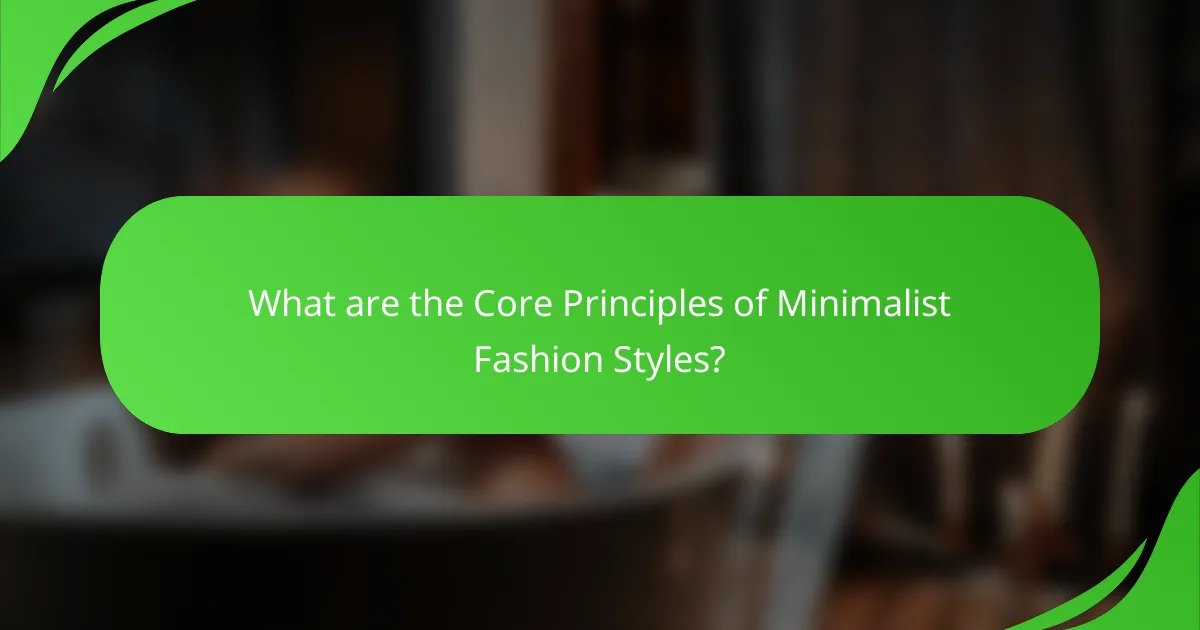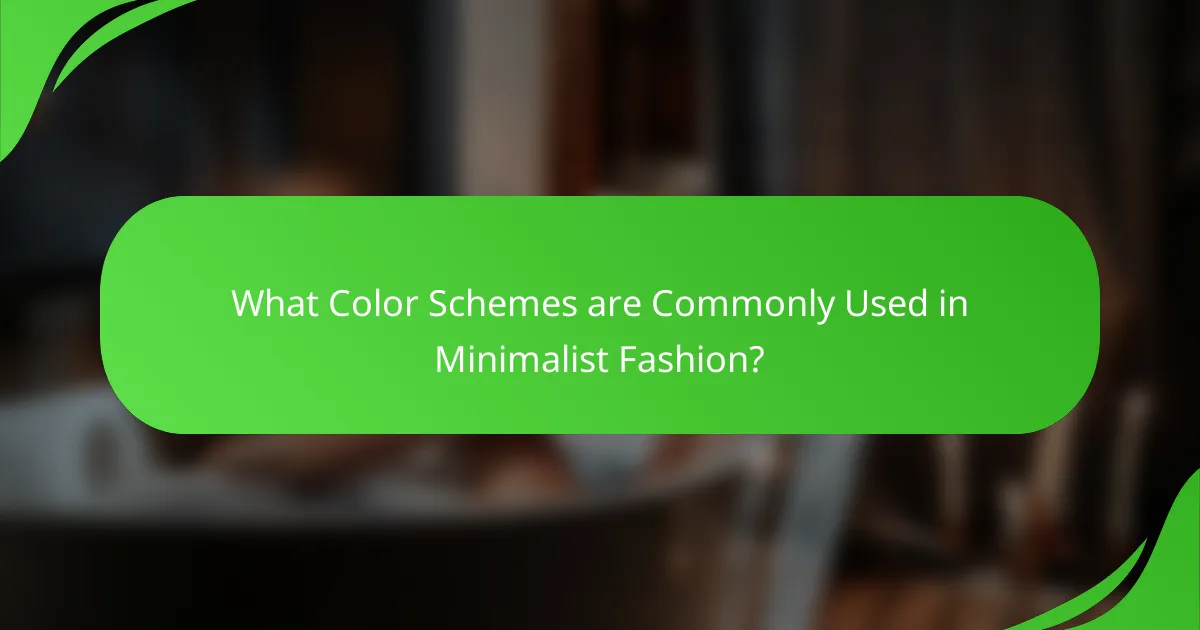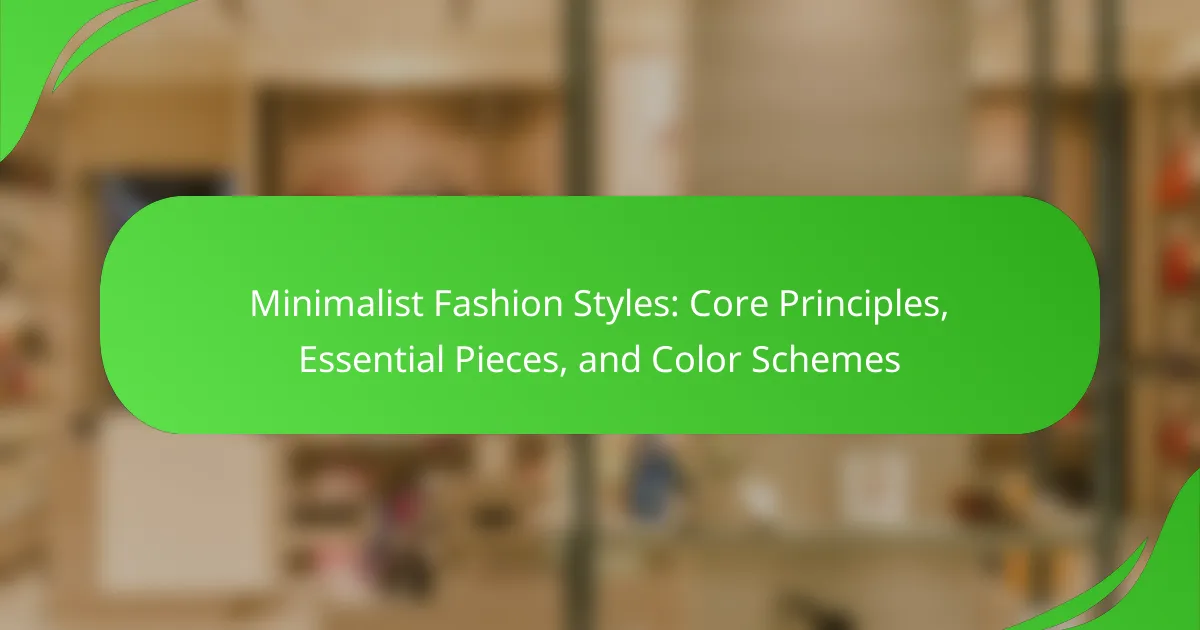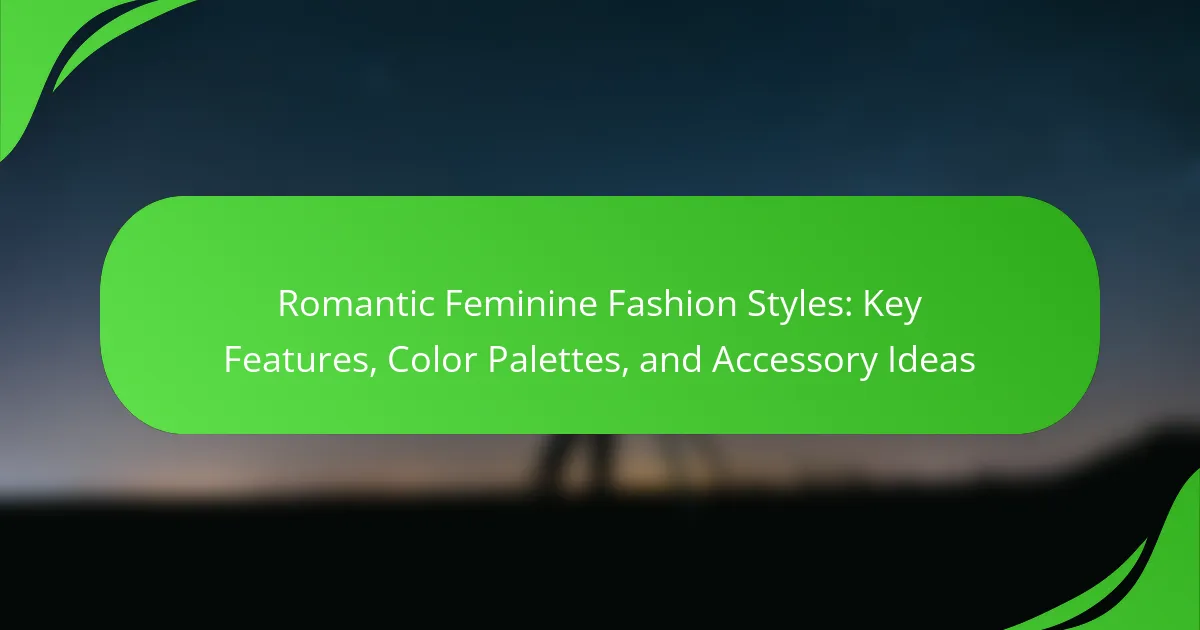Minimalist fashion styles prioritize simplicity and functionality, characterized by clean lines, uncluttered designs, and a focus on quality over quantity. Essential pieces include versatile items such as a white button-up shirt, tailored trousers, and a little black dress, all chosen for their ability to mix and match seamlessly. Common color schemes feature neutral, monochromatic, and earthy tones, emphasizing elegance without excess. This fashion approach promotes a sustainable wardrobe by reducing reliance on fast fashion and encourages a streamlined aesthetic with minimal accessories. Overall, minimalist fashion embodies timelessness and versatility in clothing choices.

What are the Core Principles of Minimalist Fashion Styles?
The core principles of minimalist fashion styles emphasize simplicity and functionality. Minimalist fashion focuses on clean lines and uncluttered designs. The use of neutral colors is prevalent, promoting versatility in outfits. Quality over quantity is prioritized, encouraging investment in timeless pieces. Each item is chosen for its ability to mix and match effortlessly. The overall aesthetic aims for elegance without excess. Minimalist fashion often features fewer accessories to maintain a streamlined look. This approach fosters a sustainable wardrobe by reducing the need for fast fashion consumption.
How does Minimalist Fashion prioritize simplicity?
Minimalist fashion prioritizes simplicity by focusing on clean lines and essential pieces. It eliminates excess and unnecessary details. The core principle is to create a streamlined wardrobe. This approach emphasizes quality over quantity. Minimalist fashion often features neutral color palettes. It encourages versatile and timeless clothing choices. This style aims for functionality and ease of wear. Research shows that minimalist fashion can reduce decision fatigue in daily dressing.
What role does functionality play in Minimalist Fashion?
Functionality is a central tenet of minimalist fashion. It emphasizes practicality and utility in clothing choices. Minimalist fashion prioritizes versatile pieces that serve multiple purposes. This approach reduces clutter and promotes a streamlined wardrobe. Functional garments often feature quality materials and timeless designs. They are designed for comfort and ease of movement. The focus on functionality aligns with the minimalist ethos of simplicity. This results in clothing that is both aesthetically pleasing and practical for everyday wear.
Why is versatility important in Minimalist Fashion?
Versatility is crucial in minimalist fashion because it allows for multiple outfit combinations with fewer pieces. This approach emphasizes quality over quantity, promoting a sustainable wardrobe. Versatile clothing can transition from casual to formal settings easily. For instance, a simple black dress can be styled for various occasions. This adaptability minimizes the need for excessive clothing purchases. It also encourages creativity in styling, enhancing personal expression. Ultimately, versatility aligns with minimalist principles by reducing clutter and promoting intentionality in fashion choices.
How does Minimalist Fashion emphasize quality over quantity?
Minimalist fashion emphasizes quality over quantity by prioritizing well-made, timeless pieces. This approach reduces the number of items in a wardrobe. Each piece is chosen for its durability and versatility. High-quality materials are often used, ensuring longevity. Minimalist fashion encourages thoughtful consumption. Consumers are urged to invest in fewer, better items. This results in a more sustainable fashion practice. Studies show that quality garments reduce waste and promote a more ethical industry. Thus, minimalist fashion advocates for a curated wardrobe that values craftsmanship over excess.
What materials are commonly used in Minimalist Fashion?
Common materials used in Minimalist Fashion include cotton, linen, wool, and silk. These fabrics are favored for their simplicity and versatility. Cotton is breathable and easy to care for. Linen offers a natural texture and is lightweight. Wool provides warmth and durability. Silk adds a touch of luxury while remaining understated. Minimalist designs often emphasize quality over quantity, leading to a preference for these timeless materials.
How do ethical considerations influence Minimalist Fashion choices?
Ethical considerations significantly influence Minimalist Fashion choices by promoting sustainability and reducing waste. Minimalist fashion emphasizes quality over quantity, encouraging consumers to invest in durable, ethically produced garments. This approach aligns with the growing demand for transparency in the fashion industry. Studies show that 66% of consumers are willing to pay more for sustainable brands. Additionally, ethical considerations drive the use of eco-friendly materials, such as organic cotton and recycled fabrics. This shift not only supports environmental conservation but also fosters fair labor practices. As a result, minimalist fashion becomes a statement of values, reflecting the wearer’s commitment to ethical consumption.
What is the significance of a neutral color palette in Minimalist Fashion?
A neutral color palette in Minimalist Fashion signifies simplicity and versatility. It allows for easy mixing and matching of garments. Neutral tones create a timeless aesthetic that transcends trends. This palette promotes a sense of calm and cohesion in outfits. Research indicates that neutral colors can enhance the perception of elegance and sophistication. According to a study by the Fashion Institute of Technology, neutral shades are preferred for their adaptability in various settings. Overall, the use of neutral colors aligns with the core principles of Minimalist Fashion, emphasizing quality over quantity.
How do color choices impact the overall aesthetic of Minimalist Fashion?
Color choices significantly influence the overall aesthetic of Minimalist Fashion. A limited color palette creates a clean and cohesive look. Neutral colors like black, white, and gray dominate, emphasizing simplicity. These colors enhance versatility, allowing for easy mixing and matching. Bright or bold colors can be used sparingly to create focal points. This approach maintains the minimalist ethos while adding visual interest. Research indicates that color psychology affects perceptions of style and elegance. A study by Eiseman (2010) highlights how color choices impact consumer emotions and brand identity. Therefore, thoughtful color selection is essential in achieving the desired minimalist aesthetic.
What are the psychological effects of neutral colors in fashion?
Neutral colors in fashion evoke feelings of calmness and stability. These colors, such as beige, gray, and white, promote a sense of balance. They are often associated with simplicity and sophistication. Wearing neutral colors can enhance feelings of professionalism and confidence. Research shows that neutral tones can reduce anxiety and create a serene environment. A study by the Color Marketing Group found that neutral colors are preferred in professional settings for their timeless appeal. This preference reflects a psychological desire for reliability and trustworthiness. Overall, neutral colors in fashion can significantly influence mood and perception.

What are the Essential Pieces in Minimalist Fashion?
Essential pieces in minimalist fashion include a white button-up shirt, tailored trousers, and a little black dress. These items are versatile and can be styled in various ways. A classic white t-shirt is also fundamental for layering. High-quality denim jeans add a casual yet polished look. Minimalist footwear typically consists of simple sneakers or ankle boots. A structured blazer enhances the overall outfit while maintaining simplicity. Accessories should be minimal, such as a sleek watch or a small handbag. These pieces embody the essence of minimalist fashion, focusing on functionality and timelessness.
What are the must-have items in a Minimalist wardrobe?
A Minimalist wardrobe must include essential items that provide versatility and simplicity. Key pieces are a white button-up shirt, black trousers, and a neutral t-shirt. A classic pair of jeans is also essential for casual wear. Footwear should consist of a pair of black or white sneakers and versatile flats or loafers. Outerwear should include a tailored blazer and a neutral coat for layering. Accessories should be minimal, focusing on a quality watch and a simple handbag. These items allow for multiple outfit combinations while adhering to minimalist principles.
How do basic tees fit into Minimalist Fashion?
Basic tees are essential components of minimalist fashion. They embody simplicity and versatility, aligning with the core principles of minimalism. Basic tees typically feature neutral colors and uncomplicated designs. This allows them to be easily paired with various bottoms and layers. Their understated nature promotes a clean aesthetic, which is a hallmark of minimalist style. Additionally, basic tees can be worn in multiple settings, from casual to semi-formal. Their timeless appeal makes them a staple in a minimalist wardrobe. Studies show that incorporating versatile pieces like basic tees can enhance sustainable fashion practices.
What is the importance of tailored trousers in Minimalist wardrobes?
Tailored trousers are essential in minimalist wardrobes due to their versatility and timeless appeal. They offer a clean, structured silhouette that complements various tops. This adaptability allows for seamless transitions between casual and formal settings. Tailored trousers often feature high-quality fabrics, ensuring durability and comfort. Their neutral colors align with the minimalist principle of a cohesive color palette. Additionally, they can be styled with minimal accessories, enhancing the overall simplicity of the outfit. The investment in tailored trousers is justified by their longevity and ability to remain stylish across seasons.
How can accessories enhance a Minimalist look?
Accessories can enhance a Minimalist look by adding subtle elegance and personal expression. They serve as focal points that draw attention without overwhelming the outfit. Simple jewelry, such as a delicate necklace or stud earrings, complements the clean lines of minimalist clothing. A structured handbag can provide functionality while maintaining a streamlined aesthetic. Footwear choices, like sleek loafers or minimalist sneakers, can elevate the overall appearance. Accessories also allow for versatility, enabling a single outfit to transition from day to night. By choosing quality over quantity, accessories reinforce the minimalist philosophy of intentionality in fashion.
What types of bags are preferred in Minimalist Fashion?
In minimalist fashion, preferred bags include tote bags, crossbody bags, and backpacks. Tote bags are valued for their simplicity and functionality. They are often made from durable materials and come in neutral colors. Crossbody bags offer hands-free convenience and a sleek silhouette. These bags typically feature clean lines and minimal embellishments. Backpacks are also popular, providing practicality and comfort. They are often designed with a streamlined look and functional compartments. Overall, these bag types align with the minimalist aesthetic, emphasizing utility and understated elegance.
How do shoes complement Minimalist outfits?
Shoes complement minimalist outfits by enhancing simplicity and functionality. They serve as a crucial element in achieving a clean and cohesive look. Minimalist fashion emphasizes neutral colors and streamlined silhouettes. Shoes that align with this aesthetic often include classic designs like loafers, sneakers, or ankle boots. These styles maintain the outfit’s overall understated vibe. Additionally, the choice of footwear can add subtle texture or contrast without overwhelming the outfit. For example, a pair of sleek black loafers can elevate a simple white shirt and jeans combination. This balance is key in minimalist fashion, where less is more.
What role do layering pieces play in Minimalist Fashion?
Layering pieces are essential in Minimalist Fashion as they provide versatility and functionality. They allow for the creation of multiple outfits from a limited wardrobe. Layering enhances the aesthetic appeal by adding depth and texture to simple silhouettes. It also facilitates adaptability to varying weather conditions, promoting practicality. Minimalist fashion emphasizes quality over quantity, making layering pieces valuable investments. They can be easily mixed and matched, maximizing outfit options. This approach aligns with the minimalist principle of simplicity while maintaining style.
How can outerwear be styled in a Minimalist way?
Outerwear can be styled in a Minimalist way by focusing on simplicity and functionality. Choose clean lines and neutral colors for a streamlined look. Opt for high-quality fabrics that provide both comfort and durability. Layering is essential; pair a tailored coat with a basic turtleneck and slim-fit trousers. Accessories should be minimal; select a structured bag and simple footwear. Avoid excessive embellishments to maintain a cohesive aesthetic. This approach emphasizes the beauty of understated elegance, which is a hallmark of Minimalist fashion.
What are some examples of versatile layering options?
Versatile layering options include lightweight turtlenecks, long-sleeve tees, and cardigans. These pieces can be easily combined for different looks. A lightweight turtleneck can be worn under dresses or blazers. Long-sleeve tees provide comfort and can be layered under jackets. Cardigans add warmth and can be styled open or closed. Each of these items is suitable for various seasons. They offer flexibility in creating outfits. Their neutral colors often align with minimalist fashion principles. This adaptability makes them essential in a minimalist wardrobe.

What Color Schemes are Commonly Used in Minimalist Fashion?
Common color schemes used in minimalist fashion include monochromatic, neutral, and earthy tones. Monochromatic schemes utilize varying shades of a single color. Neutral colors such as black, white, gray, and beige dominate minimalist wardrobes. Earthy tones, including olive green and terracotta, add warmth without overwhelming the aesthetic. These color schemes emphasize simplicity and elegance. Minimalist fashion often prioritizes functionality over flamboyance. This approach allows for versatility and timelessness in clothing choices.
How do monochromatic color schemes work in Minimalist Fashion?
Monochromatic color schemes in minimalist fashion utilize a single color in varying shades, tones, and tints. This approach creates a cohesive and harmonious look. It emphasizes simplicity and reduces visual clutter. Minimalist fashion often prioritizes function and form, making monochromatic schemes ideal. They allow for easy mixing and matching of pieces. This style can enhance the wearer’s silhouette and create an elongated appearance. Monochromatic outfits can convey sophistication and elegance. Designers like Jil Sander and Calvin Klein frequently employ this technique in their collections.
What are the benefits of using a single color palette?
Using a single color palette simplifies design and enhances visual coherence. It creates a unified look that can convey a strong brand identity. This approach reduces decision fatigue when selecting outfits or designs. A single color palette can also highlight key features of clothing or accessories. It allows for easy mixing and matching of pieces. Studies show that cohesive color schemes can improve audience perception and engagement. Additionally, a minimalist aesthetic often leads to a more timeless style. By focusing on fewer colors, one can emphasize form and texture over complexity.
How can textures enhance a monochromatic look?
Textures enhance a monochromatic look by adding depth and visual interest. Monochromatic outfits rely on a single color, which can appear flat. Incorporating various textures creates contrast within the same color scheme. For example, combining silk, cotton, and leather can elevate the overall aesthetic. Textures can also influence the perception of formality. A mix of textures can make an outfit more dynamic and engaging. This approach allows for personal expression while maintaining a cohesive look. Studies show that texture variation can significantly impact visual appeal in fashion.
What is the impact of accent colors in Minimalist outfits?
Accent colors in Minimalist outfits enhance visual interest and provide contrast. They break the monotony of neutral tones commonly used in Minimalism. The strategic use of accent colors can highlight specific features of an outfit. For instance, a bright accessory can draw attention to a simple silhouette. This approach maintains the overall simplicity while adding a personal touch. Studies show that color psychology affects perception and mood. Therefore, accent colors can evoke emotions and create a distinctive style. Overall, they play a significant role in defining a minimalist aesthetic.
How can a pop of color be effectively incorporated?
A pop of color can be effectively incorporated by using bold accessories. Accessories like scarves, belts, or bags can add vibrant hues to an outfit. This method allows for a striking contrast against neutral tones commonly found in minimalist fashion. Additionally, incorporating colorful footwear can enhance the overall look without overwhelming it. For instance, a bright pair of shoes can serve as a focal point. Layering with colorful outerwear also provides a dynamic visual interest. These techniques maintain the minimalist aesthetic while introducing eye-catching elements. Research indicates that strategic color placement can increase visual appeal and personal expression in fashion.
What are some popular accent colors in Minimalist Fashion?
Popular accent colors in Minimalist Fashion include soft pastels, muted earth tones, and monochromatic shades. Soft pastels like blush pink and baby blue add a subtle touch of color. Muted earth tones such as olive green and terracotta provide warmth without overwhelming the outfit. Monochromatic shades, including shades of gray, black, and white, maintain a clean and cohesive look. These colors enhance the minimalist aesthetic by allowing for versatility while keeping the overall style understated.
How does color theory apply to Minimalist Fashion choices?
Color theory significantly influences minimalist fashion choices by emphasizing simplicity and harmony. Minimalist fashion often utilizes a limited color palette to create cohesive looks. This approach relies on the psychological effects of colors to convey mood and style. For instance, neutral colors like black, white, and beige promote a clean and sophisticated appearance.
Additionally, color theory suggests that complementary colors can enhance visual interest without overwhelming the design. Minimalist fashion often incorporates monochromatic schemes, which focus on varying shades of a single color to maintain simplicity. This strategy aligns with the minimalist principle of “less is more.”
Research indicates that color choices can affect consumer perception and emotional response. A study by K. H. K. K. (2019) found that color schemes in fashion can influence buyer behavior, highlighting the importance of color in minimalist design. Thus, color theory serves as a foundational element in crafting minimalist fashion that is both aesthetically pleasing and psychologically impactful.
What are the relationships between different colors in Minimalist palettes?
Minimalist palettes utilize a limited color scheme to create harmony and simplicity. The relationships between colors in these palettes often focus on complementary and analogous color schemes. Complementary colors enhance each other when paired together, creating contrast and visual interest. Analogous colors, on the other hand, are adjacent on the color wheel, providing a more subtle and cohesive look.
In minimalist design, neutral colors like white, gray, and black serve as a base. These colors allow for bolder hues to stand out without overwhelming the overall aesthetic. Additionally, the use of monochromatic schemes can create depth through varying shades and tints of a single color.
Research in color theory supports these principles, highlighting how color relationships impact perception and emotional response. For example, a study by the Institute for Color Research found that color combinations can influence mood and behavior, reinforcing the significance of thoughtful color choices in minimalist palettes.
How can understanding color theory improve styling in Minimalist Fashion?
Understanding color theory enhances styling in Minimalist Fashion by enabling effective color combinations. It allows for the creation of cohesive outfits that reflect simplicity and elegance. By utilizing a limited color palette, stylists can emphasize essential pieces. Color theory also aids in selecting hues that complement skin tones and personal styles. Research indicates that color harmony can influence perceptions of professionalism and creativity. Thus, applying color theory can elevate the overall aesthetic and impact of minimalist outfits.
What are some practical tips for adopting Minimalist Fashion styles?
Start with a capsule wardrobe. This includes versatile pieces that can be mixed and matched. Choose neutral colors for easy coordination. Invest in high-quality basics that last longer. Limit accessories to a few essential items. Prioritize functionality over trends in your clothing choices. Regularly declutter your wardrobe to maintain minimalism. Follow the one-in-one-out rule to control new purchases.
How can one start building a Minimalist wardrobe effectively?
To start building a Minimalist wardrobe effectively, begin by decluttering your current clothing. Remove items that you do not wear or love. Next, identify your personal style and the essential pieces you need. Focus on versatile items that can be mixed and matched. Aim for a limited color palette to simplify outfit choices. Invest in quality over quantity for durability and timelessness. Regularly reassess your wardrobe to maintain minimalism. Research shows that a minimalist approach can reduce decision fatigue and enhance personal style.
What strategies can help maintain a Minimalist approach to fashion?
To maintain a Minimalist approach to fashion, prioritize quality over quantity. Invest in versatile, timeless pieces. Choose a neutral color palette to enhance mix-and-match potential. Regularly assess your wardrobe to eliminate non-essential items. Limit shopping to intentional purchases that align with your style. Embrace a capsule wardrobe concept, focusing on a few essential items. Follow minimalist influencers for inspiration and guidance. These strategies help sustain a streamlined, functional wardrobe.
Minimalist fashion styles prioritize simplicity, functionality, and quality, emphasizing clean lines and neutral color palettes. The article explores core principles such as the importance of versatility, essential wardrobe pieces, and the role of ethical considerations in fashion choices. It also discusses common materials, layering techniques, and the impact of color schemes, including monochromatic and accent colors, on minimalist aesthetics. Practical tips for building and maintaining a minimalist wardrobe are provided, highlighting the benefits of a curated and sustainable approach to fashion.


